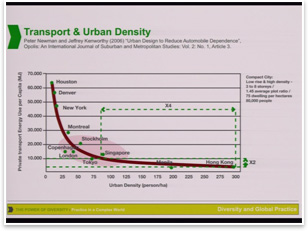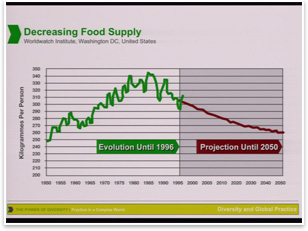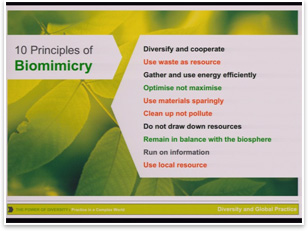|
The Dawning of the Ecological Age
by Douglas E. Gordon, Hon. AIA
Executive Editor
Summary: The
AIA 2009 National Convention
and Design Exposition in San Francisco
kicked off on April 30 with a thought-provoking theme presentation
from Arup director and civil engineer Peter
Head, OBE, FREng, FRSA, who detailed how urban and suburban areas
can aim to accommodate millions of people with no impact to the environment.
Watch the video presentation. Read
the story below.
 As the world has shifted from agriculture into the industrial age
and on to the information age over the last 200 years, there has
been one common result, Head says. Architects working with engineers
have been at the heart of the design and delivery of the essential
infrastructure for energy, water, waste, communications, transport,
and flood protection. “Energy consumption is central to our
model of human development and in designing and building these systems
we have created the hard wiring of a non-renewable fossil fuel resource
consuming society.” As the world has shifted from agriculture into the industrial age
and on to the information age over the last 200 years, there has
been one common result, Head says. Architects working with engineers
have been at the heart of the design and delivery of the essential
infrastructure for energy, water, waste, communications, transport,
and flood protection. “Energy consumption is central to our
model of human development and in designing and building these systems
we have created the hard wiring of a non-renewable fossil fuel resource
consuming society.”
 To turn that trend around—a trend that is destroying this planet,
we must address three questions: To turn that trend around—a trend that is destroying this planet,
we must address three questions:
- Can we move towards a sustainable
way of living with up to 9 billion people and create what is being
called the Ecological Age?
- What policies and investments are needed
in low-, middle-, and high -income countries?
- What is the role of
the architect in leading this transition to an Ecological Age?
Account overdrawn
The World Wildlife Federation’s 2006
Planet Report showed that
we are now living in severe ecological overshoot, Head contends. “We
are now consuming 25 percent more resources than the planet can replace
and are drawing down the stock of natural capital that supports our
lives,” he says. And, of course,
this includes resources most of us tend to take for granted, such
as water.
 “The very long-term objective is to reach a sustainable
lifestyle that uses renewable resources and the energy from the sun,” Head
explains. “We need to find a soft transition over the longest
possible period, so we can use fossil fuels and nuclear power as
long as resources are available but with much less environmental
pollution.” “The very long-term objective is to reach a sustainable
lifestyle that uses renewable resources and the energy from the sun,” Head
explains. “We need to find a soft transition over the longest
possible period, so we can use fossil fuels and nuclear power as
long as resources are available but with much less environmental
pollution.”
We tend to address each problem we have created in our development
model with another fossil-fuel dependent fix, and we have therefore
created a stack of interdependent resource consuming technologies,
according to Head. The good news is we are actually so wasteful,
he says, that there are many opportunities for rapid improvement.
The good news is we are actually so wasteful that there are many
opportunities for rapid improvement
Virtuous cycles of benefit
“In our work, we have found that by resolving each problem
in an appropriate way, the social, economic, and environmental benefits
achieved can be surprisingly large through what we call virtuous
cycles of benefit,” he says.
He uses as an example compact development where everyone walks or
bicycles to accomplish their daily routine, thus saving money and
resources, reducing pollution, and improving health. Vancouver is
a good example, he says, adding: “Good urban design and planning
is therefore a key to a successful change of direction, and that
is why this civil engineer is now in planning!”
The benefits achieved can be surprisingly large through what Arup
calls virtuous cycles of benefit
How do we do it?
All this points to finding a way to live more harmoniously with the
natural world. So how do we get there quickly enough? Among Head’s
many blueprints offered in his presentation:
Good urban design: This means employing an eco-city urbanization
model, with its higher land-use density, combined with building high-speed
rail lines and moving to energy-efficient manufacturing. Also, information
management will help people use their infrastructure more efficiently.
Rethinking transport: Much of the higher energy use by urban dwellers
in the U.S.—as opposed to China and countries in Europe—comes
from private transport. A substantial reduction in petrol and diesel
use in private vehicles in urban areas will be necessary, and battery
and hydrogen fuel-cell powered vehicles, as well as car-sharing clubs,
will add to the mix.
 Transition to food, water, energy, and waste
resource efficiency:
Productivity of land for vegetables and fruit can be improved using
new low-energy processes of building and balancing soil fertility,
and this can be assisted by closing the resource loops between
urban living and rural food production. Major opportunities also
abound to use much less water, treat and recycle urban wastewater,
and use drip feed systems for agriculture. Also viable is collecting
and storing rainwater and using it as graywater for secondary uses. Transition to food, water, energy, and waste
resource efficiency:
Productivity of land for vegetables and fruit can be improved using
new low-energy processes of building and balancing soil fertility,
and this can be assisted by closing the resource loops between
urban living and rural food production. Major opportunities also
abound to use much less water, treat and recycle urban wastewater,
and use drip feed systems for agriculture. Also viable is collecting
and storing rainwater and using it as graywater for secondary uses.
 Fuel and energy: Actions
center on wisely conserving and using our remaining fossil fuels
while developing renewables, including sun, wind, and biofuels. Fuel and energy: Actions
center on wisely conserving and using our remaining fossil fuels
while developing renewables, including sun, wind, and biofuels.
Biomimicry: Janine Benyus’ book, Biomimicry, sets out 10 principles
that successful organisms on the planet adopt, starting with “diversify
and cooperate,” the theme of Head’s talk. We can use
them as a road map. For instance, manufacturers will need to be clustered
using industrial symbiosis principles, which means sharing resources
and having integrated supply chain management.
 Waste—Clean up not pollute: On
pollution, there is a virtuous cycle between using waste as a resource
and not polluting the air, water, and soil. Health costs go down
and biodiversity and carbon sinks go up. For instance, solid waste
can be digested in anaerobic digesters to provide energy and compost
and water that can be recycled for use to grow food. Waste—Clean up not pollute: On
pollution, there is a virtuous cycle between using waste as a resource
and not polluting the air, water, and soil. Health costs go down
and biodiversity and carbon sinks go up. For instance, solid waste
can be digested in anaerobic digesters to provide energy and compost
and water that can be recycled for use to grow food.
A global effort and a defining moment
Head showed videos of models of how these principles could be turned
into action, beginning with planning frameworks for retrofitting
sustainable infrastructure for both urban and suburban areas.
Policy clearly is needed, and needed quickly at global, national,
and regional scale—and global is the most difficult, Head says.
He agrees with Prince Charles, who posits we have about 100 months
to concentrate our efforts on “declaring war on climate change.
Arup would love to connect with you on these efforts,” he said.
Head acknowledges that he offers a first glimpse of a way forward
that is a credible vision of the future, but is only a modest start
for a long journey. He is looking forward to the Copenhagen
Climate Summit in December 2009 as a time for the world to come together
on these crucial issues. He expresses hope that the global community
of designers will come together to understand what we need to do
and inspire young people to join in the challenge. Finally, he invites
the young architects present to “help old duffers like me move
quickly in the right direction.” |


 As the world has shifted from agriculture into the industrial age
and on to the information age over the last 200 years, there has
been one common result, Head says. Architects working with engineers
have been at the heart of the design and delivery of the essential
infrastructure for energy, water, waste, communications, transport,
and flood protection. “Energy consumption is central to our
model of human development and in designing and building these systems
we have created the hard wiring of a non-renewable fossil fuel resource
consuming society.”
As the world has shifted from agriculture into the industrial age
and on to the information age over the last 200 years, there has
been one common result, Head says. Architects working with engineers
have been at the heart of the design and delivery of the essential
infrastructure for energy, water, waste, communications, transport,
and flood protection. “Energy consumption is central to our
model of human development and in designing and building these systems
we have created the hard wiring of a non-renewable fossil fuel resource
consuming society.” To turn that trend around—a trend that is destroying this planet,
we must address three questions:
To turn that trend around—a trend that is destroying this planet,
we must address three questions: “The very long-term objective is to reach a sustainable
lifestyle that uses renewable resources and the energy from the sun,” Head
explains. “We need to find a soft transition over the longest
possible period, so we can use fossil fuels and nuclear power as
long as resources are available but with much less environmental
pollution.”
“The very long-term objective is to reach a sustainable
lifestyle that uses renewable resources and the energy from the sun,” Head
explains. “We need to find a soft transition over the longest
possible period, so we can use fossil fuels and nuclear power as
long as resources are available but with much less environmental
pollution.” Transition to food, water, energy, and waste
resource efficiency:
Transition to food, water, energy, and waste
resource efficiency: Fuel and energy:
Fuel and energy: Waste—Clean up not pollute:
Waste—Clean up not pollute: